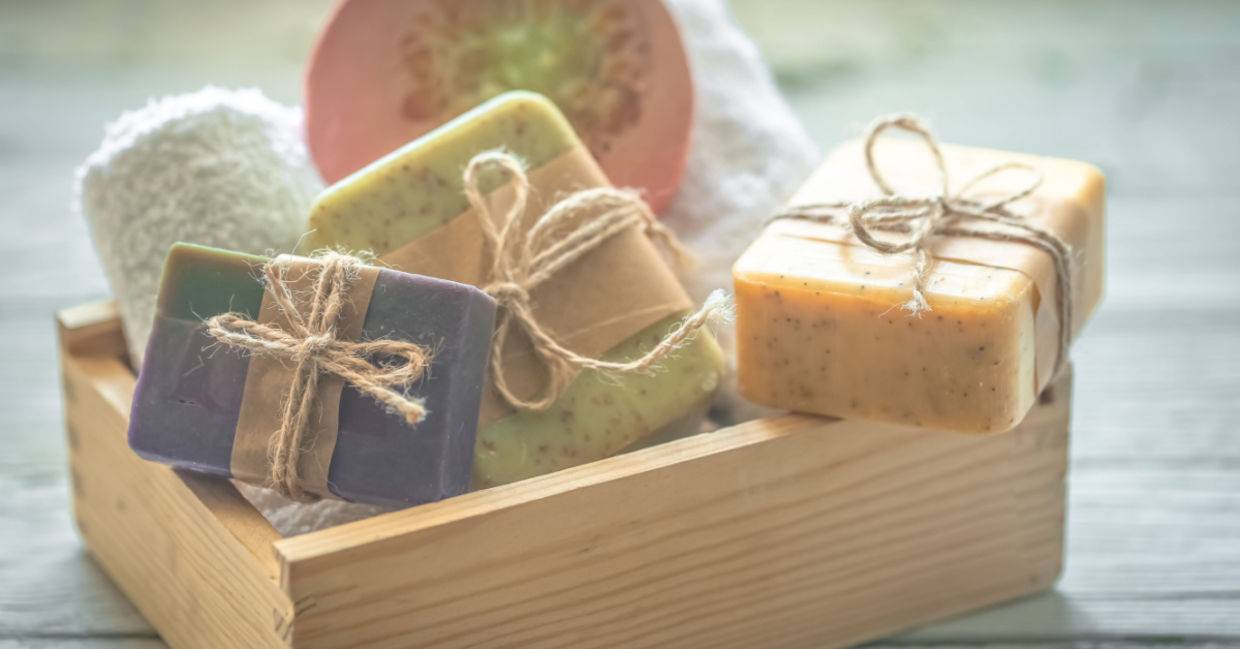
(PV productions / Shutterstock.com)
Aromatic, natural, and nourishing, bathing with a bar of homemade soap is a real pleasure. Making DIY natural soaps is easy and is a fun, creative project. Unlike store-bought manufactured soaps, handmade bars are chemical free and are healing for body, mind, and soul.
Moisturizing glycerin
One of the important byproducts of soap making is glycerin, a natural moisturizer that draws in moisture and can heal skin. But manufacturers actually remove this precious ingredient when they make soap, according to the Econut Natural website. By extracting the glycerin, they extend the shelf life of the product and can then put this extra glycerin into moisturizers.
Manufacturers also add chemicals to their soaps that may cause damage to the immunological, respiratory, endocrine, and reproductive systems. Antibacterial soaps contain sulfates, parabens, and other dangerous chemicals that may induce skin allergies. As a result, many people who cleanse with these soaps also experience dry, itchy, and ashy skin.
Health benefits of handmade soaps
Conversely, handmade soaps are healing as they are preservative-free and contain moisturizing glycerin. The antibacterial element is achieved by adding natural essential oils such as eucalyptus, tea tree, peppermint, or lavender. Need a mood boost? Unlike synthetic aromas found in manufactured soap, essential oils put in the homemade version naturally activate mood enhancing and relaxing neurochemicals.
Ready to embrace a healthy change and enjoy a fun craft? Healthline defines soap making as heating a fat with an alkali known as lye (sodium hydroxide) to cause a chemical reaction called saponification. There are two ways to make soaps: hot and cold process. The hot option takes one day, whereas the cold process can take four to six weeks to harden.
Hot process method
One needs a slow cooker, measuring cups, kitchen scale, silicone spatula, candy thermometer, an immersion blender, silicone molds, and soap cutter. Purchase lye online or at a hardware store and precisely measure it out by using an online lye calculator.
As for the oil, one can use olive oil, coconut oil, shea butter, almond oil, avocado oil or any other favorite. The water should be distilled or switched out for coconut milk, goat milk, tea, or for an exfoliating texture, coffee. Have on hand favorite essential oils, dried flower petals, and herbs.
As this involves a chemical reaction, take precautions by wearing safety goggles, protective gloves, oven mitts, an apron, and always work in a well-ventilated area. The most important chemical rule (to avoid a volcanic eruption) is to always mix the lye into the water and not vice versa.
Melt and pour method
As the fumes from the chemical process may be dangerous for children, another option is to use a pre-combined soap base. This is called the melt and pour method, explains Good Housekeeping. The soap base may contain soap, glycerin, and plant butters, so all one has to do is heat it, whisk it, mix in a color and fragrance, then pour it into silicone molds.
After using homemade soap, there may be no going back to manufactured soap! Healthy and toxin free, people say their skin feels better, according to the Healing Harvest Homestead school. Natural homemade soap is especially important for tender and sensitive babies’ skin. Customize the soap by adding herbal teas to create an anti-itch formula, use favorite essential oils, or put in natural clay. Add rosemary sprigs, oatmeal, dried rose buds, or lavender.
Avoid those store-bought plastic-wrapped soap bars and be environmentally conscious. Instead, wrap the soaps with paper, tuck in a lavender sprig, and tie with twine. This craft creates rustic, spa-like soaps that family and friends can enjoy and also promotes healthy, moisturized, and well-nourished skin!
YOU MIGHT ALSO LIKE:
Time for DIY: A Perfect Route to Home Decorating on a Budget
7 DIY All Natural Air Fresheners
How to Make a DIY Home Air Purifier







